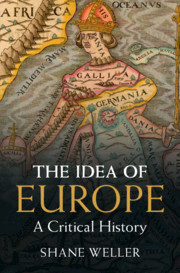Book contents
- The Idea of Europe
- The Idea of Europe
- Copyright page
- Contents
- Acknowledgments
- Introduction
- Chapter 1 Myths of Europa: From Classical Antiquity to the Enlightenment
- Chapter 2 A Great Republic of Cultivated Minds: 1712–1815
- Chapter 3 Nationalism and Universalism: 1815–1848
- Chapter 4 The Russia Question
- Chapter 5 Homo Europaeus: 1848–1918
- Chapter 6 The European Spirit: 1918–1933
- Chapter 7 A New European Order: 1933–1945
- Chapter 8 Unity in Diversity: 1945–1989
- Chapter 9 Other Europes
- Chapter 10 Europe against Itself: 1989 to the Present Day
- Conclusion Good Europeans?
- Notes
- Bibliography
- Index
Chapter 6 - The European Spirit: 1918–1933
Published online by Cambridge University Press: 14 May 2021
- The Idea of Europe
- The Idea of Europe
- Copyright page
- Contents
- Acknowledgments
- Introduction
- Chapter 1 Myths of Europa: From Classical Antiquity to the Enlightenment
- Chapter 2 A Great Republic of Cultivated Minds: 1712–1815
- Chapter 3 Nationalism and Universalism: 1815–1848
- Chapter 4 The Russia Question
- Chapter 5 Homo Europaeus: 1848–1918
- Chapter 6 The European Spirit: 1918–1933
- Chapter 7 A New European Order: 1933–1945
- Chapter 8 Unity in Diversity: 1945–1989
- Chapter 9 Other Europes
- Chapter 10 Europe against Itself: 1989 to the Present Day
- Conclusion Good Europeans?
- Notes
- Bibliography
- Index
Summary
Following the catastrophe of the First World War, which many saw as the result of nationalist rivalries, the immediate postwar period was dominated by concerns regarding European decadence and by dreams of a united Europe that would be able to regain its geopolitical power in a new global landscape increasingly dominated by the United States of America and by Russia. The French writer Paul Valéry set the agenda by arguing for a genuinely “European spirit” that had arisen out of the confluence of classical antiquity and Christianity. He was followed in this endeavor to champion a distinctly European spirit by writers such as Hugo von Hofmannsthal and Hermann von Keyserling. Chapter 6 charts the development of this idea of a European spirit, as well as the various plans for a politically united Europe, most notably as Richard Coudenhove-Kalergi’s proposals for what he termed “Pan-Europe.” The chapter reveals the cultural supremacism that taints many of these attempts to identify a European spirit, as well as emphasis placed on the need for European to re-establish its geopolitical and geo-cultural influence.
Keywords
- Type
- Chapter
- Information
- The Idea of EuropeA Critical History, pp. 141 - 166Publisher: Cambridge University PressPrint publication year: 2021



